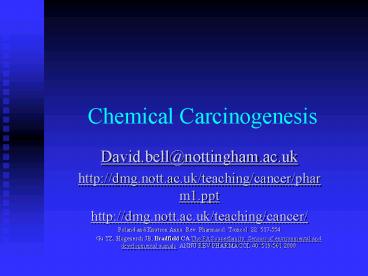Chemical Carcinogenesis
1 / 23
Title: Chemical Carcinogenesis
1
Chemical Carcinogenesis
- David.bell_at_nottingham.ac.uk
- http//dmg.nott.ac.uk/teaching/cancer/pharm1.ppt
- http//dmg.nott.ac.uk/teaching/cancer/
- Poland and Knutson Annu. Rev. Pharmacol. Toxicol.
22 517-554 - Gu YZ, Hogenesch JB, Bradfield CA The PAS
superfamily Sensors of environmental and
developmental signals ANNU REV PHARMACOL 40
519-561 2000
2
Latency
Cancer takes 10-50 years to develop in man
1900- Cigarette smoking an accepted habit
1940- rise in male lung cancer- alarm
1960- smoking is shown to be the cause of lung
cancer
1960-2000. People who started smoking before
1960 die of lung cancer Lung cancer is the most
frequent site of cancer in UK men
3
Causes of cancer
Note that diet, tobacco, occupation, alcohol and
pollution are principally chemically-induced
cancers.
4
Screening for carcinogens
- Animal tests
- 50 animals per group
- Maximal tolerated dose (MTD), and 25
- Cost 250 000
- Time 2 years (rat or mouse)
5
Problems with bioassay
- The US National Toxicology Programme has tested gt
500 compounds, with selection based solely on
environmental relevance - Approx 59 of all chemicals cause cancer
- Food 1000s of chemicals
6
Genotoxins vs non-genotoxins
- Mutagenic (genotoxic) carcinogens can be easily
detected (e.g. Ames test) - Non-genotoxic carcinogens account for 30-50 of
rodent bioassay carcinogens - No clear test for non-genotoxins
- Consequences for development of pharmaceuticals
7
The numbering of the beast
4
6
3
5
7
8
2
10
9
1
2,3,7,8 tetrachlorodibenzo-p-dioxin (TCDD) One of
the most potent of a variety of related
compounds Long half-life in humans (6 years)
8
TCDD is a potent toxin
- LD50 values
- 1mg/kg guinea pig
- 20-50mg/kg rat
- 70mg/kg monkey
- 5000mg/kg hamster
- Highly toxic in chicken, fish
- Lethality involves a wasting syndrome,
involving many bodily organs, and taking 2-4 weeks
9
TCDD and cancer
- Tumorigenic in rat, mouse, guinea pig and fish
(everything tested) - Primate study aborted when total dose of 2 mg/kg
lead to death - In rat, the lowest carcinogenic dose was 1.4
ng/kg/day (Plt0.05) for thyroid tumours - MTD 71ng/kg/day
10
A prototypical non-genotoxin
- TCDD is a potent carcinogen
- Very weak/ no mutagenicity in Ames test
- No activity in tests of DNA damage
- Maximum estimate for binding of TCDD to rat liver
DNA 1 molecule per 1011 bases - 1 per 107- 105 for known carcinogens
- TCDD is a non-genotoxic carcinogen
11
TCDD is a tumour promoter
DEN
Vehicle control- 6 months
0 tumours
DEN
TCDD- 6 months
5/7 tumours
TCDD- 6 months
0 tumours
12
History of TCDD
- 1976 Seveso (http//www.roche.com/roche/about/esev
esa.htm) - A reaction vessel containing trichlorophenol
overheated, and exploded. The resulting TCDD
contamination (gt100g) led to the evacuation of
people over a wide area. - 1999 Belgium
- Chick edema disease- contaminated chicken
foodstuffs
13
Pleiotropic response
- Induction of
- cytochromes P450 1A1, 1A2 and 1B1
- CYP1A1 is known as aryl hydrocarbon hydroxylase
(AHH) - all three P450s are potent in the metabolism of
aromatic hydrocarbons - UPDGT
- GST
14
Related chemicals
Cl
Cl
Cl
Cl
- Chlorinated dibenzofurans
- Chlorinated biphenyls
- Chlorinated naphthalenes
- Polycyclic Aromatic Hydrocarbons
- Similar effects
- Less potent
- Same pleiotropic response
O
15
Structure-Activity Relationships
- The ED50 for induction of AHH in chick embryo is
0.3 nmol/kg with TCDD - 15 different halogenated DbDs showed an SAR for
induction of AHH - gt 3 Cl
- Occupy 2,3,7,8 positions
- gt1 ring position unsubstituted
- Correlation between potency for inducing AHH and
toxicity
16
SARs- PAH
- 3-methylcholanthrene (3MC) is a PAH
- Induces AHH (CYP1A1)
- TCDD and 3MC in rat liver
- Produce similar maximal induction response for
AHH - Administration of both compounds produces no
additive effect - Parallel dose-response curves
- TCDD 30,000 times more potent (ED50 0.8
nmol/kg)
17
A genetic locus in mice
- PAHs induce AHH (ie P450) in the skin (and liver)
of mice - But there is genetic variation
- DBA/2 mice do not induce with 3MC
- C57Bl/6J mice do induce with 3MC
- Responsiveness maps as an autosomal dominant
between C57 and DBA - the Ah locus (Aryl Hydrocarbon)
- TCDD induces in all mice strains
18
Ah locus
- Two possibilities
- (a) 3MC, TCDD have distinct receptors
- (b) the same receptor
- Dose response for TCDD in responsive and
non-responsive strains - The dose of TCDD required for induction is
10-fold greater in non-responsive strains of mice
19
Ah Locus
- AHH responsive mice are about 10-fold more
sensitive than non-responsive mice to - Thymic involution
- Hepatic porphyria
- Teratogenesis
- The Ah locus controls toxicity
- How does Ah work ?
20
Ah encodes a receptor
- Receptor identified in the liver cytosol of
C57Bl/6 mice - High affinity 0.2 nMolar
- 8 pMols receptor/ gm liver
- 50 000 molecules/ liver cell
- Lower affinity receptor in DBA/2 mice
- Correlation between ability to bind various
compounds and potency for induction
21
Ah Receptor
- Human AhR is 96 kDa
- Binds dioxin directly
- Family of cellular signalling receptors
1
805
228
416
HLH
PAS1
PAS2
Transactivation
Ligand-Binding Domain 190 amino acids, 25 kDa
22
AhR and dioxin signalling
TCDD
Arnt
AhR
Transcription
hsp90
23
AhR -/- mice
- Transgenic mice without AhR gene
- Unable to induce cytochrome P450 by TCDD, PAH
- TCDD toxicity vastly reduced (gt100 fold)
- Greatly reduced tumour incidence in skin after
application of Benzo(a)Pyrene - Due to AhR
- Or to lack of induction of cytochrome P450 ?































